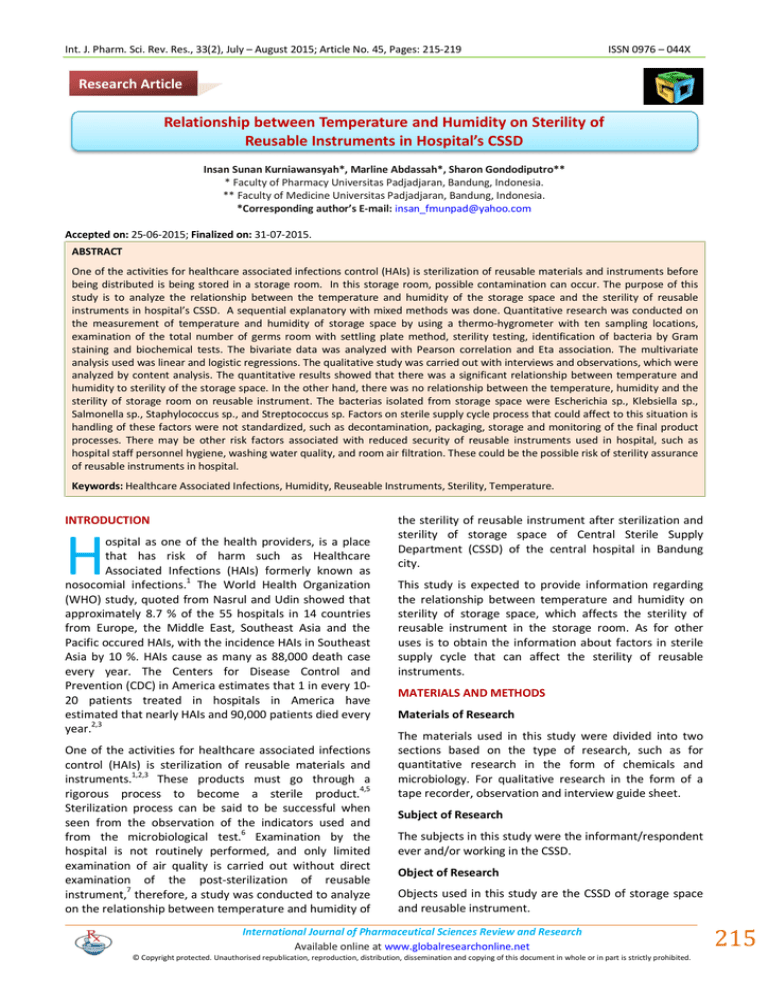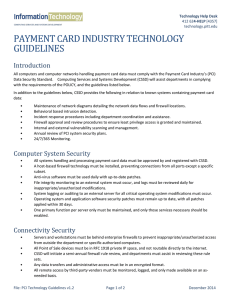Document 13310588
advertisement

Int. J. Pharm. Sci. Rev. Res., 33(2), July – August 2015; Article No. 45, Pages: 215-219 ISSN 0976 – 044X Research Article Relationship between Temperature and Humidity on Sterility of Reusable Instruments in Hospital’s CSSD Insan Sunan Kurniawansyah*, Marline Abdassah*, Sharon Gondodiputro** * Faculty of Pharmacy Universitas Padjadjaran, Bandung, Indonesia. ** Faculty of Medicine Universitas Padjadjaran, Bandung, Indonesia. *Corresponding author’s E-mail: insan_fmunpad@yahoo.com Accepted on: 25-06-2015; Finalized on: 31-07-2015. ABSTRACT One of the activities for healthcare associated infections control (HAIs) is sterilization of reusable materials and instruments before being distributed is being stored in a storage room. In this storage room, possible contamination can occur. The purpose of this study is to analyze the relationship between the temperature and humidity of the storage space and the sterility of reusable instruments in hospital’s CSSD. A sequential explanatory with mixed methods was done. Quantitative research was conducted on the measurement of temperature and humidity of storage space by using a thermo-hygrometer with ten sampling locations, examination of the total number of germs room with settling plate method, sterility testing, identification of bacteria by Gram staining and biochemical tests. The bivariate data was analyzed with Pearson correlation and Eta association. The multivariate analysis used was linear and logistic regressions. The qualitative study was carried out with interviews and observations, which were analyzed by content analysis. The quantitative results showed that there was a significant relationship between temperature and humidity to sterility of the storage space. In the other hand, there was no relationship between the temperature, humidity and the sterility of storage room on reusable instrument. The bacterias isolated from storage space were Escherichia sp., Klebsiella sp., Salmonella sp., Staphylococcus sp., and Streptococcus sp. Factors on sterile supply cycle process that could affect to this situation is handling of these factors were not standardized, such as decontamination, packaging, storage and monitoring of the final product processes. There may be other risk factors associated with reduced security of reusable instruments used in hospital, such as hospital staff personnel hygiene, washing water quality, and room air filtration. These could be the possible risk of sterility assurance of reusable instruments in hospital. Keywords: Healthcare Associated Infections, Humidity, Reuseable Instruments, Sterility, Temperature. INTRODUCTION H ospital as one of the health providers, is a place that has risk of harm such as Healthcare Associated Infections (HAIs) formerly known as nosocomial infections.1 The World Health Organization (WHO) study, quoted from Nasrul and Udin showed that approximately 8.7 % of the 55 hospitals in 14 countries from Europe, the Middle East, Southeast Asia and the Pacific occured HAIs, with the incidence HAIs in Southeast Asia by 10 %. HAIs cause as many as 88,000 death case every year. The Centers for Disease Control and Prevention (CDC) in America estimates that 1 in every 1020 patients treated in hospitals in America have estimated that nearly HAIs and 90,000 patients died every 2,3 year. One of the activities for healthcare associated infections control (HAIs) is sterilization of reusable materials and instruments.1,2,3 These products must go through a rigorous process to become a sterile product.4,5 Sterilization process can be said to be successful when seen from the observation of the indicators used and from the microbiological test.6 Examination by the hospital is not routinely performed, and only limited examination of air quality is carried out without direct examination of the post-sterilization of reusable instrument,7 therefore, a study was conducted to analyze on the relationship between temperature and humidity of the sterility of reusable instrument after sterilization and sterility of storage space of Central Sterile Supply Department (CSSD) of the central hospital in Bandung city. This study is expected to provide information regarding the relationship between temperature and humidity on sterility of storage space, which affects the sterility of reusable instrument in the storage room. As for other uses is to obtain the information about factors in sterile supply cycle that can affect the sterility of reusable instruments. MATERIALS AND METHODS Materials of Research The materials used in this study were divided into two sections based on the type of research, such as for quantitative research in the form of chemicals and microbiology. For qualitative research in the form of a tape recorder, observation and interview guide sheet. Subject of Research The subjects in this study were the informant/respondent ever and/or working in the CSSD. Object of Research Objects used in this study are the CSSD of storage space and reusable instrument. International Journal of Pharmaceutical Sciences Review and Research Available online at www.globalresearchonline.net © Copyright protected. Unauthorised republication, reproduction, distribution, dissemination and copying of this document in whole or in part is strictly prohibited. 215 Int. J. Pharm. Sci. Rev. Res., 33(2), July – August 2015; Article No. 45, Pages: 215-219 Inclusion and Exclusion Criterias In this study, the inclusion criteria for the study were defined, and there are no exclusion criteria. For inclusion criteria are divided as follows: a) Storage space (1) It is part of the CSSD. ISSN 0976 – 044X a) Descriptive, ie. for data on the temperature and humidity in the storage space.8,9,11 b) Bivariate, ie. to the data on the relationship between the sterility of storage space (the total number of germs) against the sterility of reusable instruments, analyzed using association test Eta (η).8,9,16 c) Multivariate (2) Directly related to the sterilization chamber (3) Has the HVAC control system Multivariate analysis used were linear regression and logistic regression.9,17 b) Reusable instrument 2) Qualitative Research (1) The sample is in the storage space CSSD. Analysis of qualitative research with data collection through interviews, conducted descriptively through five 9,10 stages, namely: (2) Samples must be sterile, indicated by the sterility indicator. a) Transcription of the interview (3) The packaging is not damaged, or wet. (4) Samples of instrument should be sealed by the packaging. (5) Samples containing products should include batch production time (sterilization) and expiry time. c) Respondent b) Reduction of data c) The process of coding (coding) d) Categorization e) Verification/Conclusion Implications/Ethical Aspects of Research (1) Health workers in the hospital under study Ethical aspects of research are: (2) Work / have worked in the CSSD in hospital under study. 1) Respect for the person a) Introduce yourself as researchers Design of Research The study design of these research is mixed methods of qualitative and quantitative research.8,9,10,11 Study of Design The design study is a sequential explanatory, where quantitative data is collected in advance, then the qualitative data collected for clarification on matters relating to the results of the quantitative data.8,9,11 Flow carried quantitative research with the following details: b) Disclose the purpose and objectives of the research c) Request permission to study in place that will be examined d) Request the help on the use of tools, materials and space for research e) Request willingness to conduct interviews 2) Non-maleficence Beneficience c) Examination on the sterility of storage space.14 The advantage gained by respondents include research information regarding the level of sterility of storage space and installation of medical instrument in the workplace, so it can be used as a basis for formulating the policy of sterile supplies. Lost obtained by the respondent is loosing time and disruption of work comfort by participating in this study. d) The sterility testing of the reusable instruments.14 3) Justice a) Measurement of temperature and humidity.7,12,13 b) Examination on the sterility of instrument after sterilization.4,5,14 e) Bacteria Identification. Observations and qualitative research 12,15 interviews was conducted for For over time and disruption of work comfort of the respondents, the researchers provided feedback in the form of awards and souvenirs. RESULTS Analysis Design The design of the research analysis conducted by the research problem is structured as follows: The results obtained from laboratory testing, observation, and interviews, described as follows: Quantitative Research 1) Quantitative Research. Analysis was performed on the following data types: 1. Measurement of Temperature and Humidity in CSSD Storage Room International Journal of Pharmaceutical Sciences Review and Research Available online at www.globalresearchonline.net © Copyright protected. Unauthorised republication, reproduction, distribution, dissemination and copying of this document in whole or in part is strictly prohibited. 216 Int. J. Pharm. Sci. Rev. Res., 33(2), July – August 2015; Article No. 45, Pages: 215-219 The results of the overall average temperature of storage space CSSD is 26.24 0C with minimum temperature is 25.30 0C and maximum temperature is 27.20 0C with 0 standard deviation (SD) of 0.64 C. While the overall average humidity of storage space CSSD was 52.15 % with a minimum humidity of 47 % and a maximum humidity of 57 % with standard deviation (SD) of 3.28 %. 2. Calculation of Total Score Germs in CSSD Storage Room The frequency of the total number of bacteria that often 3 appear (mode) is at 4 cfu/m as much as 10 times. 3. Sterility Test of Reusable Instrument in CSSD Space Storage Sterility tests carried out on sets of reusable sterile instrument contained in the CSSD storage space. Of the 40 samples tested on sterility, it was found that 9 sets of the instrument was not sterile or by 22.5 %. 4. Identification of Bacteria From air samples, can be identified five types of bacteria, namely Escherichia sp., Klebsiella sp., Salmonella sp., Staphylococcus sp., and Streptococcus sp. Qualitative Research The results of the qualitative research interview process, is based on the recordings, transcripts produced as many as 18 sheets. The encoding process was done after the data is reduced and produces 47 statement with 27 attributes. Grouping category of 27 attributes obtained produce five groups category or theme, namely the arrangement of the air, cleaning/decontamination, packaging, storage and monitoring products. From 27 observations data, there are six data that does not comply with the requirements of storage space and two data does not correspond to the sterile supply cycle in CSSD. Hypothesis Testing Based on calculations, the results obtained by linear regression analysis with significance (p-value) of 0.033 (smaller than the p-value 0.05) so the Ho is rejected. In conclusion there is a significant relationship between temperature with humidity of the storage space in CSSD. Large relationships between variables, which were analyzed using Pearson correlation was found that is a relationship between the temperature and the sterility of storage space with a low level of correlation (0.385). While the correlation between humidity and sterility storage space (number of bacteria) is very low (0.094).18 For the relationship between the temperature and humidity with the sterility of reusable instrument in storage space CSSD, the result was no significant correlation (significance value 0.760 > 0.05). Likewise, the relationship between the total number of germs with the sterility of reusable instrument, large association was ISSN 0976 – 044X found which is 0.040, which means low relationship level.18 For overall test, it showed no significant relationship between temperature, humidity and the total number of germs with the sterility of reusable instrument in storage space CSSD. DISCUSSION Based on interviews and observations, it was found that there are several factors that causes the temperature of the storage space does not meet the requirements, which are: 1) centralized control system, so the setting can not be done directly by CSSD. In addition, temperature indicator used was faulty. 2) The possibility of leakage on temperature distribution line from the center to the storage room. This is possible because the temperature in the room to another party contained in CSSD as packing space, the temperature reached 23.3 0C. Based on the test results of bacterial identification of five types of bacteria were identified, all of the bacterias are potential bacteria that causes hospital infections. Parwati et al. maps outlines the circumstances of some bacteria in the hospital ward under study, where these bacteria maps depict common bacteria that cause infections. Some of the bacteria that can be isolated from various specimens, which are five types of bacteria found in this research.15 Based on the research results, we know that the environmental conditions support, can stimulate the growth and reproduction of bacteria. Environmental factors that affect the growth and reproduction of bacteria are temperature and humidity. Temperature plays an important role in regulating the course of metabolic reactions for all living things. Especially for bacteria, environmental temperature which is higher than the temperature that can be tolerated, will cause denaturation of proteins and other essential cell components causial the cell to die.6,7 Similarly said by Boyce, Mitchell and Gu that bacterias generally requires a relative humidity (RH), quite high, 6,12 approximately 85 % . So in maintaining sterility of the storage space to note the HVAC room with adequate lighting, temperatures between 18-22 0C and 35-75 % humidity, ventilation using a positive pressure system with the particular filtration efficiency between 90-95 % (for the particular size of 0.5 microns ).1,7 Factors such as temperature and humidity do not have relationship with the sterility of reusable instrument, which indicated that there are other factors that could cause reusable instrument contained in the storage space in CSSD to be non-sterile. International Journal of Pharmaceutical Sciences Review and Research Available online at www.globalresearchonline.net © Copyright protected. Unauthorised republication, reproduction, distribution, dissemination and copying of this document in whole or in part is strictly prohibited. 217 Int. J. Pharm. Sci. Rev. Res., 33(2), July – August 2015; Article No. 45, Pages: 215-219 The discovery of reusable instrument that is not sterile, is attributed to the parameters associated with storage space, can also be caused by handling process before and after the sterilization process is done. Pre-sterilization treatment was good (including decontamination, cleaning and packaging) and post-sterilization (storage process) should be considered to be able to produce goods that are sterile. Perfection in sterilization process depends on the process of reducing the number of microorganisms before sterilization through a good cleaning and prevention of recontamination before use.1,4 Limitations of Research In this study, there are some factors that cannot be carried out by researchers due to the limitations of the study, including: 1) This research was carried out only in the storage space CSSD in one of the hospitals. Thus, the results cannot be generalized to all the storage space CSSD. 2) The number of samples of reusable instrument examined was as much as 40 sets, only because there are several factors beyond the ability of researchers such as time and availability of samples from the hospital as well as the cost factor. 3) Examination on the sterility of reusable instrument is not carried out on instrument that has been distributed to the treatment rooms in hospitals. This is because it consumes more time, effort and increases the cost. Based on the study's limitations, it is advisable to conduct further examinations either by the hospital authority on other researchers. handling, decontamination, packaging, storage and monitoring of the final product. Acknowledgment: Immeasurable appreciation and deepest gratitude for the help and support are extented to Dr. Deni Kurniadi Sunjaya, dr., DESS., Dra. Emma Surahman, MS., Apt., Prof. Dr. Ridad Agoes, dr., Sp.Par-K, MPH., Angga Prawira Kautsar, MARS., Apt., Dr. Mieke Herniawati, drg., MS. and Dr. H. Sadeli Masria, dr., MS., SpMK., DMM. Not to forget also to Nina Kirana Poetri Trijuliati, SKp., Dra. Hegandari Sarasti Rahayu, Apt., and his staff for all the assistance given to the author. As well as to the other parties which can not be mentioned one by one who helped me, either directly or indirectly. Hopefully this article will be useful for the development of science, and those in need, especially in the field of Hospital Pharmacy. REFERENCES 1. Direktorat Jendral Bina Pelayanan Medik, Pedoman Instalasi Pusat Sterilisasi di Rumah Sakit, Departemen Kesehatan Republik Indonesia, Jakarta, 2009, 1-2, 8-9, 24-8, 44-9, 60. 2. Rosenthal VD, Device-associated nosocomial infections in limited-resources countries: Findings of the International Nosocomial Infection Control Consortium (INICC), American Journal of Infection Control, 36(10), 2008, S171.e7-12. 3. Yokoe DS, Mermel LA, Anderson DJ, Arias KM, Burstin H, Calfee DP, Coffin SE, et al., A compendium of strategies to prevent healthcare-associated infections in acute care hospitals, Infection Control Hospital Epidemiology, 2008, 29:S12-S21. 4. Huys J, The sterile supply cycle, World Forum for Hospital Sterile Supply, 2011, Available from: <http://www.wfhss.com>. [accessed on : 12 Maret 2012]. 5. Chaubey PC, Rampai, Estimation of sterilization capacity in supercriticalty tertiary care hospital in South East Asia region, Journal of the Academia of Hospital Administration, 17(2), 2005,1-12. 6. Boyce JM, Environmental contamination makes an important contribution to hospital infection, Journal of Hospital Infection, 65, Issue SUPPL. 2, 2007, 50-54. 7. Bruna CQdM and Graziano KU, Temperature and humidity in the storage area of sterile materials: a literature review, Brazil, 2012, Available from: <http://www.ee.usp.br/reeusp/>. [accessed on : 17 April 2013]. 8. Dahlan MS, Langkah-langkah membuat proposal penelitian bidang kedokteran dan kesehatan, 2(3), Sagung Seto, Jakarta, 2009, 93-106, 114-24. CONCLUSION Based on the results of research and discussion on the relationship of temperature and humidity on the sterility of reusable instrument and installation of storage space CSSD one of the hospitals, the conclusion can be stated as follows: 1) There is a relationship between temperature and humidity with sterility of storage space CSSD. However, the strength of the relationship between the sterility of the storage space is low temperature, and very low humidity. 2) Temperature and humidity are not related to the sterility of reusable instrument in the hospital’s CSSD. 3) Temperature, humidity and sterility of storage space is unrelated to the sterility of reusable instrument in the hospital’s CSSD. 4) The sterility of the storage space is not related to the sterility of reusable instrument in the hospital’s CSSD. 5) The factors that could affect the sterility of storage space and reusable instrument in the hospital’s CSSD is the handling of sterile supply cycle process that is not accordance to the standards-compliant, ie the air ISSN 0976 – 044X 9. Cresswell JW, Research design: Pendekatan kualitatif, kuantitatif, dan mixed, 3, Penerjemah: Achmad Fawaid, Pustaka Pelajar, Yogyakarta, 2010,. 21-9, 133-5, 167-90, 314-17. 10. Herdiansyah H, Metodologi penelitian kualitatif untuk ilmuilmu sosial, Salemba Humanika, Jakarta, 2010, 101-13. 11. Sarwono J, Metode penelitian kuantitatif dan qualitative, 1, Graha Ilmu, Yogyakarta, 2006, 145-50. International Journal of Pharmaceutical Sciences Review and Research Available online at www.globalresearchonline.net © Copyright protected. Unauthorised republication, reproduction, distribution, dissemination and copying of this document in whole or in part is strictly prohibited. 218 Int. J. Pharm. Sci. Rev. Res., 33(2), July – August 2015; Article No. 45, Pages: 215-219 12. Mitchell R, Gu JD, Enviromental microbiology, 2, John Wiley & Sons, Inc., New Jersey, 2010, 199-200. 13. Sari NA, Fauziah RN, Nurbaety AT, Pengaruh suhu dan salinitas terhadap viabilitas bakteri Aeromonas hydrophila dan Bacillus sp., Institut Pertanian Bogor, 2012. 14. Departemen Kesehatan Republik Indonesia, Farmakope Indonesia Edisi IV, DepKes RI, Jakarta, 1995. 15. Parwati I, Turbawaty DK, Zainuddin A, et al., Peta bakteri dan kepekaannya terhadap berbagai antibiotika di RS Dr Hasan Sadikin Bandung, Bagian Patologi Klinik Rumah Sakit Dr. Hasan Sadikin FK Unpad, Bandung, 2006. ISSN 0976 – 044X 16. Brown DE, Statistics reference pages: Measure of association for bivariate data, Available from: <emp.byui.edu/BrownD/Statsintro/dscrptv/dscrttv_cat_vars/msrs-assn-non-num.html> [accessed on: 19 April 2013> 17. Dahlan MS, Mendiagnosis dan menata laksana 13 penyakit statistik, Seri 7, Sagung Seto, Jakarta, 2010, 3-12. 18. Garson GD, Measures of association, Asheboro, NC: Statistical Associates Publishers, 7, 2012, 46. Source of Support: Nil, Conflict of Interest: None. International Journal of Pharmaceutical Sciences Review and Research Available online at www.globalresearchonline.net © Copyright protected. Unauthorised republication, reproduction, distribution, dissemination and copying of this document in whole or in part is strictly prohibited. 219







